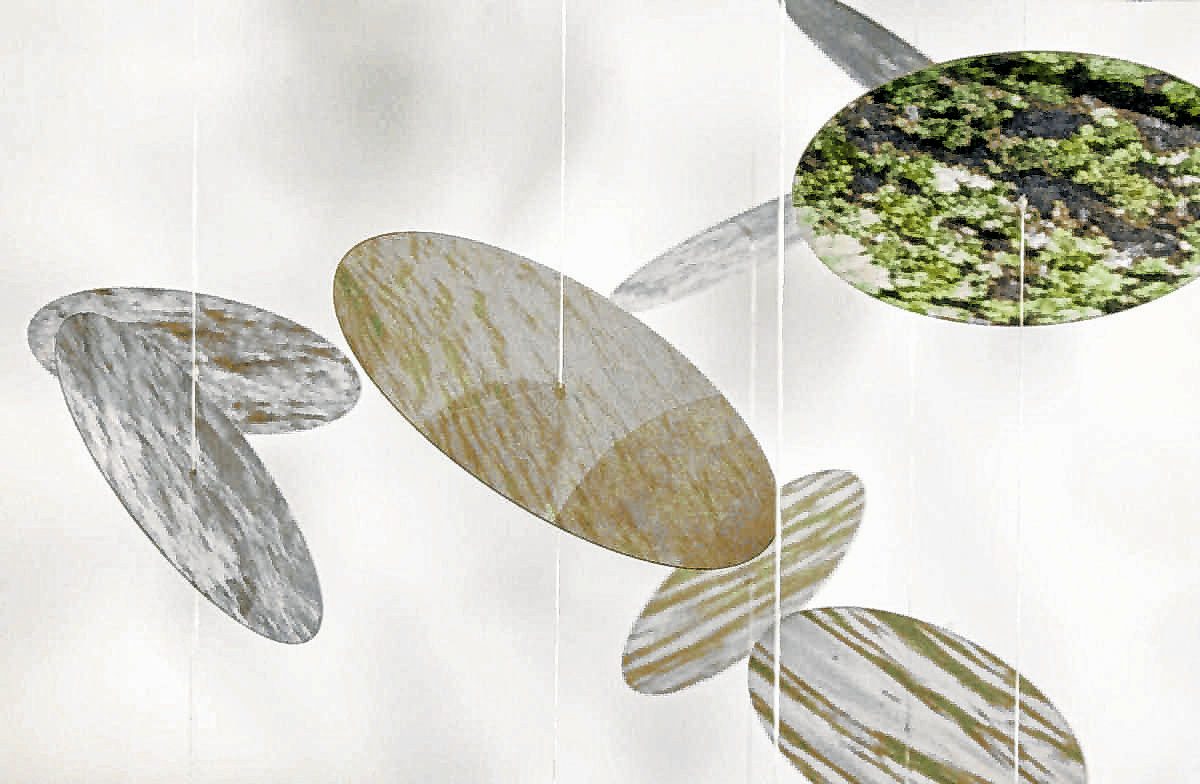This is more than woven blankets, intricate beadwork and earthen pottery.
Native American art comes with preconceived notions based on the past. But exhilarating artists working today create paintings borrowing the geometric designs from Navajo rugs and road maps. Porcupine quills and beadwork becomes the elements of mixed-media paintings blending abstract painting and Lakota artforms.
Sculptures suspended in the air are used to create a “watersong” of the Miami tribe.
[sc:text-divider text-divider-title=”Story continues below gallery” ]
“Contemporary Native artists are living and working today. They have the same kind of desire to create art that is deeply personal, made out of tradition,” said Jennifer Complo McNutt, curator of contemporary art at the Eiteljorg Museum in Indianapolis.
Some of the most stunning Native American contemporary art has come to central Indiana in a new exhibition at the Eiteljorg Museum. “Blurring the Line” features five of the most accomplished Native artists working today: abstract painter Rita Letendre, installation artist Hannah Claus, multidisciplinary artist Demian DinéYazhí, painter Matthew Alan Kirk and mixed media artist Dyani White Hawk.
Each artist takes a unique approach to interpreting the Native American experience through paintings, multimedia compositions and sculpture. Collectively, their work speaks to the breadth and inventiveness of contemporary Native art, as well as the important role is presenting an expansive view of the culture.
“We really work to show a continuum of expression from Native people, so I hope people understand that Native art can be a lot of things. It’s not just one stereotypical thing,” Complo McNutt said.
“Blurring the Line” features five artists chosen for the Eiteljorg Contemporary Art Fellowship, a prestigious competition supporting the work of Native artists working today.
Each artist received a $25,000 award, and their work is part of the exhibition as well as its catalogue and video documentation. The Eiteljorg also purchased $115,000 in works of the fellowship artists for its permanent collection.
The Eiteljorg’s commitment to supporting contemporary Native artists has made its collection one of the most complete and expansive in the entire world.
“The Eiteljorg has an incredible collection of Native American and Western art, but what really sets it apart from other institutions is the longstanding institutional commitment to Native American contemporary art,” said Elisa Phelps, vice president and chief curatorial officer at the museum, in a statement. “There are important collections of contemporary Native art in other museums, but the relationships, publications, exhibitions and collection resources that have been developed through the biennial Eiteljorg Contemporary Art Fellowship are unparalleled.”
Winner of the fellowship have their work featured in a major exhibition at the Eiteljorg, held every other year. This year, the central idea is crossing cultural lines and expanding the idea of what Native art can be, Complo McNutt said.
“I hope people take away a deeper appreciation of Native people, and their continuing tradition,” she said. “We want to help them understand that Native people are living people, and they should be able to, and do, create artwork of all kinds.”
The participating artists bring together a varying range of cultural tradition and artistic styles.
Rita Letendre, of the Abenaki tribe, is the invited artist for this round of the fellowship. The renowned abstract painter from Toronto has works featured in both Canadian and American museums.
“She is someone who is like Canadian royalty. She has been working for 50 or 60 years, and is an important public artist and an important artist in abstraction,” Complo McNutt said.
Hannah Claus is an installation artist in Montreal who creates suspended sculptures. A member of the Bay of Quinte Mohawk tribe, she created a “Miami watersong” piece for the exhibition, with digital imagery.
The politically charged installations, textile pieces and video features created by Demian DinéYazhí of the Diné tribe has earned the Portland, Oregon, artist several grants and fellowships. Matthew Alan Kirk, a Navajo, is a painter based in Queens, New York whose geometric compositions resemble road maps, Navajo rugs and urban landscapes.
Dyani White Hawk of the Sičáŋğu Lakota makes intricate mixed-media paintings that incorporate, among other elements, porcupine quills and beads with painted geometric patterns.
“Some of her designs are based on Lakota traditions, but you wouldn’t necessarily know that until you familiar with those traditions, because they’re not overt. They’re still very abstracted,” Complo McNutt said.
“Blurring the Line” will be on display at the museum through Feb. 2, 2020. Eiteljorg organizers hope that those who see it gain a better idea of how expansive the Native culture can be.
“People think there are no Native people anymore. There are; there are Native people everywhere. People have this very stereotypical impression about Native people, and this helps change that idea,” Complo McNutt said.
[sc:pullout-title pullout-title=”If you go” ][sc:pullout-text-begin]
"Blurring the Line: The Eiteljorg Contemporary Art Fellowship 2019"
What: An exhibition spotlighting this year’s five Eiteljorg fellows, all Native American artists specializing in contemporary art.
Where: Eiteljorg Museum, 500 W. Washington St., Indianapolis
When: Saturday through Feb. 2, 2020
Featured artists:
- Rita Letendre (Abenaki), a renowned abstract painter from Toronto, originally from southern Quebec, whose works are in Canadian and American museums and who is the invited artist this round
- Hannah Claus (Bay of Quinte Mohawk), an installation artist in Montreal who creates suspended sculptures and is creating a “Miami watersong” piece for the exhibition
- Demian DinéYazhí (Diné), a multidisciplinary artist from Portland, Oregon, who has been awarded several grants and fellowships and creates installations, textile pieces and video
- Matthew Alan Kirk (Navajo), a painter based in Queens, N.Y., whose geometric compositions resemble road maps, Navajo rugs and urban landscapes
- Dyani White Hawk (Sičáŋğu Lakota) of Minneapolis, who creates intricate mixed-media paintings that incorporate, among other elements, porcupine quills and beads with painted geometric patterns.
Information: eiteljorg.org
[sc:pullout-text-end]





